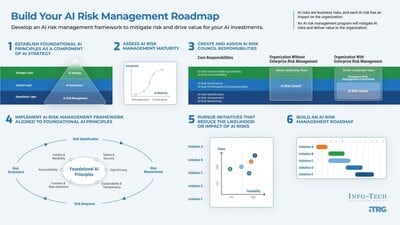As organizations rush to integrate artificial intelligence (AI) into their operations, many are realizing they are unprepared for the unique risks these systems introduce. According to Info-Tech Research Group, AI is moving faster than most companies’ existing risk controls, creating significant governance and regulatory challenges. To address these gaps, Info-Tech has released a new framework to help businesses strengthen their approach to AI risk management.
Why AI Risk Management is Vital for Modern Organizations
AI offers tremendous benefits, but it also creates new vulnerabilities such as hallucinations, bias, deepfakes, and adversarial threats. Info-Tech’s blueprint highlights that failing to manage these risks proactively can lead to major setbacks, including regulatory violations, reputational harm, and loss of business value. Despite these dangers, many companies still rely on informal or ad hoc approaches that only react after problems surface. Bill Wong, Research Fellow at Info-Tech, stresses that AI risk is a business risk, requiring executive involvement across the organization—not just from technical leaders.
Building a Robust AI Risk Framework with Info-Tech’s Blueprint
The new Info-Tech resource, Build Your AI Risk Management Roadmap, introduces a structured methodology to address these emerging challenges. The framework focuses on four key areas:
- Risk governance
- Risk identification
- Risk measurement
- Risk response
A core feature of this blueprint is aligning AI risk management with broader enterprise strategies, ensuring the entire organization supports responsible AI use. The AI Risk Council (AIRC) is central to this, bringing together IT, AI, and business leaders to ensure cross-functional accountability and ownership.
Key Steps to Implement Effective AI Risk Management Programs
Info-Tech outlines specific steps that IT and business leaders can take to operationalize AI risk management across the organization:
- Establish foundational AI principles like fairness, transparency, and safety.
- Assess current AI risk management maturity to uncover capability gaps.
- Create and assign responsibilities within the AI Risk Council.
- Implement the risk management framework, from risk governance to response strategies.
- Pursue targeted risk-mitigation initiatives based on value and feasibility.
- Translate priorities into a time-bound, actionable AI risk management roadmap.
These steps aim to move organizations from a reactive stance to a proactive, preventative mindset, enabling ongoing monitoring and stronger regulatory compliance.
In conclusion, as the adoption of AI accelerates, strong AI risk management practices are more essential than ever. Info-Tech Research Group’s framework empowers organizations to detect, assess, and mitigate risks before they become costly issues. By following the outlined steps, companies can turn risk management into a strategic advantage and keep their AI initiatives aligned with business goals.
Don’t miss our latest Startup News: Cambium Networks Delivers Game-Changing Wi-Fi Boost for Hotels
